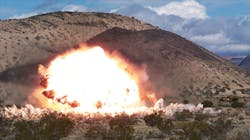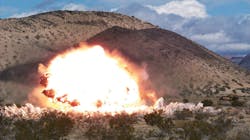Air Force asks L-3 to build radar proximity sensor to trigger air-burst munitions
HILL AIR FORCE BASE, Utah — Airborne weapons experts at L-3 Technologies Inc. will design and build an avionics radar proximity sensor to enable combat aircraft pilots the heights at which their bombs and smart munitions explode over targets under terms of a $131.8 million eight-year U.S. Air Force contract.
Officials of the Air Force Life Cycle Management Center at Hill Air Force Base, Utah, are asking the L-3 Space & Sensors-Cincinnati segment in Cincinnati to build the Cockpit-Selectable Height-of-Burst Sensor (C-HOBS).
This new avionics subsystem will replace the now-fielded Northrop Grumman DSU-33D/B height-of-burst sensor, as well as address obsolescence issues. Northrop Grumman has been building the DSU-33D/B sensor since 1999, and recently delivered the 200,000th system.
The L-3 Cockpit-Selectable Height-of-Burst Sensor (C-HOBS) will trigger a wide variety of munitions for damage-inducing air bursts.
C-HOBS is a radar proximity sensor that provides high precision variable proximity function to the fuze system. The sensor will provide manual and cockpit-selectable heights of burst, precision height sensing, and possible terrain discrimination.
The sensor will interface with various weapons systems — particularly the Joint Direct Attack Munition (JDAM) the on U.S. Navy and Air Force bomber aircraft.
C-HOBS is a modification program to resolve obsolescence issues with the DSU-33D/B sensor and to improve sensor performance. It will maintain the same form, fit and function as the DSU-33D/B, and will address certain targets of opportunity to future-proof the sensor. Details of the C-HOBS specifications are classified.
Upgrades of the C-HOBS program include manual and cockpit-selectable radar-guided height-of-burst with improved system performance for JDAM and the Next Generation Area Attack Weapons (NGAAW) missions, Air Force officials say. L-3 is expected to build as many as 60,000 C-HOBS units.
On this contract L-3 will do the work in Cincinnati, Ohio, and will be finished by April 2027.
For more information contact L-3 space & Sensors-Cincinnati online at https://cinele.com, or the Air Force Life Cycle Management Center-Hill Air Force Base at www.hill.af.mil.

